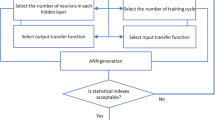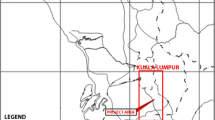Abstract
The pull-out capacity of screw piles is affected by the complex underground and geological conditions, the helical pile’s configuration, and the penetration depth. Several experimental, theoretical, and neural network methods are available to predict the pull-out capacity of these piles. However, the weaknesses of ANN with regard to slow rates of convergence as well as in finding reliable testing outputs with reasonable errors are known to be major drawbacks of implementing ANN-based techniques. The present study aimed to develop an ICA-ANN-based model to estimate the pull-out capacity of screw piles in a simple way. A total of 36 experimental observations were collected and used to train, test, and optimize the ANN using an imperialist competitive algorithm (ICA). The developed ICA-ANN model can be considered an effective method for predicting the ultimate pull-out resistance of the helical screw piles since excellent agreement is obtained with respect to the reliability of the proposed model. The overall (training and testing) errors obtained for the proposed ICA-ANN model in comparison with the experimental data are 0.706, 0.17, and 0.996 for the mean absolute error (MAE), root-mean-square error (RMSE), and correlation factor (CF) respectively.




Similar content being viewed by others
References
Al Dossary MA, Nasrabadi H (2016) Well placement optimization using imperialist competitive algorithm. J Pet Sci Eng 147:237–248
Al-Omari RR, Al-Azzawi AA, AlAbbas KA (2016) Behavior of piled rafts overlying a tunnel in sandy soil. Geomechanics and. Engineering 10(5):599–615
Armaghani DJ, Hasanipanah M, Mohamad ET (2016) A combination of the ICA-ANN model to predict air-overpressure resulting from blasting. Eng Comput 32(1):155–171
Atashpaz-Gargari E, Lucas C (2007) Imperialist competitive algorithm: an algorithm for optimization inspired by imperialistic competition. Proc., evolutionary computation, 2007. CEC 2007. IEEE Congress on, IEEE, 4661–4667
Baziar MH, Azizkandi AS, Kashkooli A (2015) Prediction of pile settlement based on cone penetration test results: an ANN approach. KSCE J Civ Eng 19(1):98–106
Briançon L, Simon B (2011) Performance of pile-supported embankment over soft soil: full-scale experiment. J Geotech Geoenviron 138(4):551–561
Byrne BW, Houlsby GT (2015) Helical piles: an innovative foundation design option for offshore wind turbines. Philos Trans R Soc A Math Phys Eng Sci 373(2035):11
Dai GL, Salgado R, Gong WM, Zhang YB (2012) Load tests on full-scale bored pile groups. Can Geotech J 49(11):1293–1308
Das S (2012) Performance of fuzzy logic-based slope tuning of neural equaliser for digital communication channel. Neural Comput Appl 21(3):423–432
Das SK, Basudhar PK (2006) Undrained lateral load capacity of piles in clay using artificial neural network. Comput Geotech 33(8):454–459
Demuth H, Beale M (2000) Neural network toolbox: for use with Matlab: computation, visualization, programming: User's guide, version 4, The Mathworks
Dong TW, Zheng YR (2015) Experiment of single screw piles under inclined cyclic pulling loading. Geomechanics and. Engineering 8(6):801–810
El Naggar MH, Wei JQ (2000) Uplift behaviour of tapered piles established from model tests. Can Geotech J 37(1):56–74
Elkasabgy M, El Naggar H (2015) Axial compressive response of large-capacity helical and driven steel piles in cohesive soil. Can Geotech J 52(2):224–243
Gavin K, Doherty P, Tolooiyan A (2014) Field investigation of the axial resistance of helical piles in dense sand. Can Geotech J 51(11):1343–1354
Ghorbani A, Jokar MRA (2016) A hybrid imperialist competitive-simulated annealing algorithm for a multisource multi-product location-routing-inventory problem. Comput Ind Eng 101:116–127
Hanna AM, Morcous G, Helmy M (2004) Efficiency of pile groups installed in cohesionless soil using artificial neural networks. Can Geotech J 41(6):1241–1249
Hataf N, Shafaghat A (2015) Numerical comparison of bearing capacity of tapered pile groups using 3D FEM. Geomech Eng 9(5):547–567
Hird CC, Stanier SA (2010) Modelling helical screw piles in clay using a transparent soil. Phys Model Geotech 1:2769–2774
Hsu ST, Hu WC (2014) Uplift behavior of shaft anchors in silty sand in Taipei Basin. J Chin Inst Eng 37(2):175–188
Kaya Z (2016) Predicting liquefaction-induced lateral spreading by using neural network and neuro-fuzzy techniques. Int J Geomech 16(4):14
Keskin MS (2015) Model studies of uplift capacity behavior of square plate anchors in geogrid-reinforced sand. Geomech Eng 8(4):595–613
Kiefa MA (1998) General regression neural networks for driven piles in cohesionless soils. J Geotech Geoenviron 124(12):1177–1185
King BA, Bjorneberg DL, Trout TJ, Mateos L, Araujo DF, Costa RN (2016) Estimation of furrow irrigation sediment loss using an artificial neural network. J Irrig Drain Eng-ASCE 142(1):8
Kordjazi A, Nejad FP, Jaksa MB (2014) Prediction of ultimate axial load-carrying capacity of piles using a support vector machine based on CPT data. Comput Geotech 55:91–102
Lee CJ, Jeon YJ, Kim SH, Park IJ (2016) The influence of tunnelling on the behaviour of pre-existing piled foundations in weathered soil. Geomechanics and. Engineering 11(4):553–570
Livneh B, El Naggar MH (2008) Axial testing and numerical modeling of square shaft helical piles under compressive and tensile loading. Can Geotech J 45(8):1142–1155
Marquardt DW (1963) An algorithm for least-squares estimation of nonlinear parameters. J Soc Ind Appl Math 11(2):431–441
Marto A, Hajihassani M, Armaghani DJ, Mohamad ET, Makhtar AM (2014) A novel approach for blast-induced flyrock prediction based on imperialist competitive algorithm and artificial neural network. Sci World J 2014(1):1–11. https://doi.org/10.1155/2014/643715
Milad F, Kamal T, Nader H, Erman O (2015) New method for predicting the ultimate bearing capacity of driven piles by using flap number. KSCE J Civ Eng 19(3):611–620
Momeni E, Nazir R, Armaghani DJ, Maizir H (2014) Prediction of pile bearing capacity using a hybrid genetic algorithm-based ANN. Measurement 57:122–131
Mosquera ZZ, Tsuha CDC, Beck AT (2016) Serviceability performance evaluation of helical piles under uplift loading. J Perform Constr Facil 30(4):11
Na K, Lee D, Lee H, Jung K, Choi H (2016) Optimum Configuration of Helical Piles with Material Cost Minimized by Harmony Search Algorithm. In: Kim JH, Geem ZW (eds) Harmony Search Algorithm. Springer-Verlag Berlin, Berlin, pp 329–340
Nazir R, Chuan HS, Niroumand H, Kassim KA (2014) Performance of single vertical helical anchor embedded in dry sand. Measurement 49:42–51
Park HI, Cho CW (2010) Neural network model for predicting the resistance of driven piles. Mar Georesour Geotechnol 28(4):324–344
Prasad Y, Rao SN (1994) Pullout behaviour of model pile and helical pile anchors subjected to lateral cyclic loading. Can Geotech J 31(1):110–119
Sakr M (2009) Performance of helical piles in oil sand. Can Geotech J 46(9):1046–1061
Sakr M (2015) Relationship between installation torque and axial capacities of helical piles in cohesionless soils. J Perform Constr Facil 29(6):11
Schiavon JA, dos Santos J, Tsuha CDC, Thorel L (2015) The occurrence of residual stresses in helical piles. Ios Press, Amsterdam
Stanier SA, Black JA, Hird CC (2014) Modelling helical screw piles in soft clay and design implications. Proc Inst Civ Eng Geotech Eng 167(5):447–460
Suman S, Das SK, Mohanty R (2016) Prediction of friction capacity of driven piles in clay using artificial intelligence techniques. Int J Geotech Eng 10(5):469–475
Tarawneh B, Imam R (2014) Regression versus artificial neural networks: predicting pile setup from empirical data. KSCE J Civ Eng 18(4):1018–1027
Tsuha CHC, Aoki N, Rault G, Thorel L, Garnier J (2010) Physical modelling of helical screw piles in sand. Phys Model Geotech 1:2841–2846
Tsuha CHC, Aoki N, Rault G, Thorel L, Garnier J (2012) Evaluation of the efficiencies of helical anchor plates in sand by centrifuge model tests. Can Geotech J 49(9):1102–1114
Tsuha CDC, dos Santos J, Santos TD (2016) Helical piles in unsaturated structured soil: a case study. Can Geotech J 53(1):103–117
Wang S-C (2003) Artificial neural network. Interdisciplinary computing in java programming, Springer, p 81–100
Xia TA, Wang W, Wang XN (2010) Artificial neural network model for time-dependent vertical bearing capacity of preformed concrete pile. Applied Mechanics and Mechanical Engineering, Pts 1–3, Tan HH (ed), Trans Tech Publications Ltd, Stafa-Zurich, 226–230
Yusof MF, Azamathulla HM, Abdullah R (2014) Prediction of soil erodibility factor for peninsular Malaysia soil series using ANN. Neural Comput Applic 24(2):383–389
Zorlu K, Gokceoglu C, Ocakoglu F, Nefeslioglu HA, Acikalin S (2008) Prediction of uniaxial compressive strength of sandstones using petrography-based models. Eng Geol 96(3):141–158
Author information
Authors and Affiliations
Corresponding author
Ethics declarations
Conflict of interest
The authors declare that they have no conflict of interest.
Rights and permissions
About this article
Cite this article
Mosallanezhad, M., Moayedi, H. Developing hybrid artificial neural network model for predicting uplift resistance of screw piles. Arab J Geosci 10, 479 (2017). https://doi.org/10.1007/s12517-017-3285-5
Received:
Accepted:
Published:
DOI: https://doi.org/10.1007/s12517-017-3285-5




